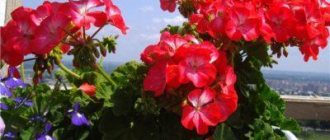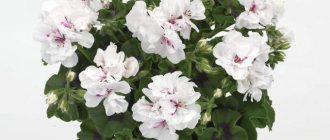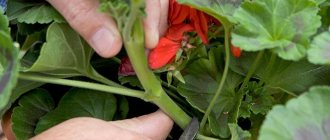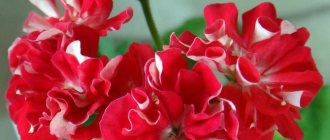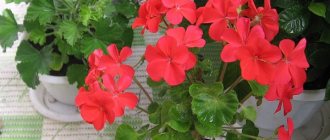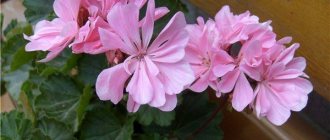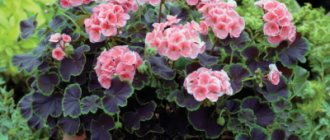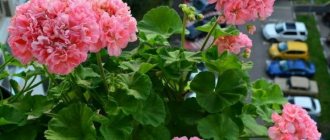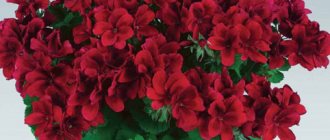The beautiful flowering plant zonal pelargonium (Pelargonium) is quite widespread in indoor culture. People most often call it geranium, and this crop is part of the Geraniaceae family. South America is considered its homeland. This is a very heat-loving plant. This is how it differs from real geranium, which is relatively resistant to cold and is found in the middle latitudes of Russia (prefers to grow in fields and meadows).
Pelargonium zonalis was named this way because its foliage has a special border - a ring zone with a dark color. The leaf blades are rounded and notched. The composition of the shoots and foliage includes special essential oils. Therefore, if you touch them, you can feel a specific aroma.
This plant is a herbaceous shrub. The height of this perennial can reach up to 0.9 m. It is a fast-growing plant, its average annual growth is about 20–30 centimeters. It needs to be renewed once every 2 or 3 years.
Flowering is observed throughout the summer period. Inflorescences can be double or simple. They are part of multi-flowered umbrella-caps. Color can vary from fiery red to white.
Brief description of cultivation
- Temperature regime . In the warm season - from 20 to 25 degrees, and in the winter months - from 13 to 15 degrees.
- Air humidity . Average.
- Illumination . A large amount of bright diffused light is needed.
- Watering . In winter, water moderately, and in summer - abundantly.
- Substrate . Universal purchased soil mixture.
- Feeding . In April–August once every 15 days.
- Transplant . In spring time. This is done when the root system becomes cramped in the pot. Transplanted using the transshipment method.
- Reproduction . By seed method and apical cuttings.
- Features of care . You need good lighting, a small container, systematic application of fertilizers, and regular moistening of the substrate. Frequent pruning and cool conditions during winter are necessary.
ZONAL PELARGONIA. WATERING. FEEDING. CARE
Subtleties of lighting and temperature
Under no circumstances should there be a lack of light for this beauty. Otherwise, it will leave you without flowers and will delight you with a half-empty stem with small leaves. To be able to observe the chic head and fragrant flowers, you need to choose the brightest place for the pot, for example, the south side of the house. But, if after some time in the sun faded yellow spots begin to appear on the leaves, then you definitely need to add shadows. In winter, small lamps are suitable for good lighting.
The heat is harmful for the little beauty. She will not tolerate 30-degree heat. The standard for zonal pelargonium F1 is a stable +20 degrees, maximum +25. Drafts and cold glass are also enemies for the plant.
Caring for zonal pelargonium at home
Pelargonium zonalis adapts quite easily to indoor conditions. She is unpretentious and undemanding.
Temperature
This plant is heat-loving. It reacts extremely negatively to temperatures below 8 degrees. The optimal temperature regime for zonal pelargonium is from 20 to 25 degrees in summer, from 13 to 15 degrees in winter. A flower can be seriously damaged by a draft, the proximity of operating heating devices, sudden changes in temperature and touching a cold glass surface.
Air humidity
This crop, growing at home, does not need to be systematically moistened. However, if the summer turns out to be too hot, the plant can be moistened with a spray bottle of well-settled water, the temperature of which is slightly higher than room temperature.
During the cold season, the air in apartments is dried out by heating devices, which negatively affects the condition of the flower. To avoid this, it is recommended to place the bush with a pot on a deep tray, which is filled with wet expanded clay.
Illumination
Any variety of this plant does not tolerate shaded areas. If the bush feels a lack of light, then it loses its decorative effect: the shoots stretch out and are exposed in the lower part, the foliage becomes smaller and becomes faded. Zonal pelargonium feels best on a southern windowsill. However, on hot summer days the plant needs to be shaded from the sun, which will prevent sunburn on the foliage.
Window sills of eastern and western orientation are also suitable for this culture. But in this case, its flowering will be shorter and less spectacular. In order for the bush to bloom as luxuriantly as possible, it requires at least 16 hours a day of bright light.
Watering
Watering should be done with great care. If the earthen lump dries out in the container, then all the foliage can quickly turn yellow. If moisture stagnation is regularly observed in the root system, this may cause rot to appear on it.
In this regard, the substrate in the pot is moistened only when it dries to a depth of 20 mm: in summer - from 3 to 4 times every 7 days, and in winter - once every 1-1.5 weeks. Some time after watering, be sure to remove the water that has flowed into the pan.
soil mixture
Choose a substrate so that it is not excessively “greasy” and nutritious. Due to the very large amount of nutrients in the soil mixture, shoots and foliage will begin to actively grow, which will negatively affect flowering.
For zonal pelargonium, a store-bought universal soil mixture is suitable. In order to make an earth mixture with your own hands, you should combine peat, humus and turf soil in equal parts. To increase drainage properties and looseness, the earth mixture is combined with coarse sand.
To prevent rot from appearing on the root system, the substrate is mixed with a small amount of charcoal. At the same time, a good drainage layer of pebbles or expanded clay is made at the bottom of the pot.
Fertilizer
In order for the plant to bloom regularly and abundantly, it is provided with fertilizing with a mineral complex with a high content of phosphorus and potassium. Since nitrogen activates increased growth of shoots and foliage, the fertilizer should contain a minimum amount. Feeding is carried out once every 15–20 days, starting from spring until the onset of autumn. You can use special fertilizers for pelargoniums or tomatoes.
If the bush was planted or transplanted not long ago, then feeding it begins only after 6 weeks. You can also use foliar feeding. To do this, use a Zircon solution: 1 tbsp. water 4 drops of the product.
Transfer
This flower can be replanted at any time during the growing season. Please note that the new container should be a little tight for the root system of the bush. In this case, zonal pelargonium will spend its energy not on actively growing green mass, but on the formation of inflorescences.
However, if the root system has grown quite strongly, then a slightly more spacious pot is chosen for replanting the bush. When transplanting an adult flower, only the substrate is replaced, while the pot is left the same.
Bloom
It blooms quite long and luxuriantly from spring until the beginning of autumn. After the umbrella-shaped inflorescences fade, they should be torn off. This helps speed up the opening of new flowers.
The color of the inflorescences is directly related to the variety. Moreover, most often they are colored pink, red, white and salmon. There are also unusual varieties: their petals are decorated with spots of different colors.
Pelargonium is quite popular among breeders. That is why today you can find varieties whose flowers are shaped like tulips, roses and cacti.
Pelargonium is zonal. How to achieve lush flowering.
Trimming
It is very important to form the crown of the bush correctly. This will ensure a compact, neat appearance and lush flowering. If you do not prune the bush in the spring and do not pinch its shoots in the fall, this will lead to stretching and bare stems and poor flowering.
During the year, 2 prunings are carried out:
- In spring to improve flowering. Shorten the stems (2–5 buds should remain on each of them).
- In autumn, to make the bush thicker. Pinch the apical buds and also remove all weakened and thin branches.
To carry out the procedure, it is recommended to use a very sharp knife or blade. To prevent infection, all instruments should be sterilized.
Community of little green men
Pelargonium Pelargonium, domestic geranium. An evergreen shrub with woody stems, jagged edges of leaves and flowers collected in large inflorescences - umbrellas of white, pink, red, lilac color, as well as with spots or stripes.
Etymology of the name
The name of the genus comes from the Greek word pelagros - “stork”: due to the resemblance of the fruits to the beak of a stork.
Pelargonium is a universal flower. It can be used as a houseplant, when landscaping flower beds, balconies, terraces, etc. These flowers are unusually impressive in hanging baskets. Dense foliage hides the container from view, while bright inflorescences create a splash of color that attracts the viewer's attention. Such baskets will give a unique look to your balcony, porch or terrace. It is quite simple to make, it requires simple care, and long flowering will provide decorativeness for a long time.
Types and varieties of pelargonium
The genus includes about 280 species of annual and perennial herbaceous plants, shrubs, and subshrubs, distributed mainly in South Africa.
Pelargonium x domesticum
A cultivated species resulting from the crossing of several species. Evergreen subshrub 45 cm high. Stems are woody and hairy. The leaves are alternate, petiolate, serrated along the edges. Flowers usually appear in spring or early summer. Large inflorescences - umbrellas of white, pink, red, lilac colors, as well as with spots or stripes - completely hide the foliage.
Pelargonium crispum 'Variegatum'
Valued for its decorative fragrant, yellow-spotted leaves with scalloped or curly edges.
Garden pelargonium or zonal pelargonium (Pelargonium x hortorum)
A cultivated species resulting from a series of crosses.
The most common type in indoor floriculture. The name of the species is associated with the brownish horseshoe-shaped pattern on the leaves, which is more pronounced in plants growing in well-lit places. This species is perhaps one of the most popular, since the plants grow well both indoors and outdoors (specimens from the garden, transplanted into containers in the fall, can bloom almost all year round). Not only compact and medium-growing varieties are popular, but also vigorous-growing cultivars. Individual flowers in umbellate inflorescences are simple, semi-double or double.
Of particular interest are varieties with star-shaped flowers. Their inflorescences seem to be collected from bird feathers - very light and delicate. A separate direction in the selection of zonal pelargoniums is the breeding of varieties with very colorful foliage. Leaf plates, on which, in addition to the characteristic horseshoe-shaped pattern, a white border appears, or the base becomes yellow, various variants of two- and three-color combinations, “take away” the decorative functions of less bright inflorescences.
Garden pelargonium, variety mixture Delta is a new pelargonium hybrid that blooms 2 weeks earlier than others. A variety with a compact bush with abundant flowering. The height of the bush is 25-30 cm.
Popular varieties and series of zonal pelargonium:
As an example, we can cite the following varieties of zonal pelargonium:
Pelargonium zonalis Algela Woodberry - large double bright red flowers;
Pelargonium zonalis Apple Blossom
— flowers are collected in white double roses with a pink border and a greenish center, type Rosebud Zonal pelargoniums. The variety is tall and requires shaping;
Pelargonium zonalis F1 Blanca
- compact bush up to 35 cm high with white flowers. The leaves are green with a characteristic dark pattern;
Pelargonium zonalis Carmel - standard non-double pelargonium,
the flowers are white with a thin pink edge;
Pelargonium zonalis Cecile Monroe
- pink (salmon) double flowers look like roses;
Pelargonium zonal Dolce Vita
— salmon flowers with a light edge, large and double;
Pelargonium zonal PAC Salmon Komtess
- a variety with double salmon-colored flowers;
Pelargonium zonalis PAC Salmon Princess - a compact variety with large, densely double flowers, pinkish flowers, darker in the center;
Pelargonium zonalis Scarlet Rambler —
compact bush with densely double flowers of two colors (red on one and light on the other), type Rosebud Zonal pelargoniums.;
Pelargonium zonal Elite Series (F1 hybrids) - varieties of this series are distinguished by large, long-lasting inflorescences of regular spherical shape and compact bush size;
Pelargonium zonal Series PAC Fireworks - the series combines varieties with star-shaped flowers (Stellar), with jagged, pointed petals, inflorescences located on very high peduncles, color - from plain white, pink, red, salmon, to two-color with a wide variety of combinations of the given shades;
Pelargonium zonal Tango Series is a series of varieties with very dark foliage and early flowering, a wide range of colors (bright red, pink, lavender, salmon, soft pink and white).
Fragrant pelargoniums have the scent of rose, lemon, and mint. Their leaves can be used like the leaves of other fragrant herbs, filling them into gift baskets, “scented” pillows, bags that are placed in laundry, etc.
Pelargonium graveolens
Subshrub up to 1 m high, with densely branched, pubescent shoots. The leaves are 5–7-lobed, pubescent, with a strong aroma. The flowers are small, pink, collected in umbrella inflorescences. Blooms in summer.
Pelargonium fragrant
Pelargonium grandiflorum
Subshrub or shrub with stems woody below. The leaves are large, round in shape, finely toothed, folded, without a border. Leaf color ranges from light to dark green. The flowers are large, up to 5–6 cm in diameter, simple or double, collected in inflorescences. Coloring ranges from white to dark red and purple, in various shades. Pelargonium grandiflora is sometimes also called English pelargonium. However, the origin of this name is not entirely clear, because in England she is known as the royal or show horse, and in the USA as “Lady Washington”.
Popular varieties of large-flowered pelargonium:
For almost two centuries, varieties of the 'Angel' group have been popular, obtained by crossing curly pelargonium (Pelargonium crispum) with the scent of lemon and royal pelargonium (Pelargonium grandiflorum). The light aroma of lemon is also preserved in the hybrids.
Pelargonium grandiflora Tip Top Duet
- 30-40 cm high, the upper petals of the flowers are dark crimson with burgundy veins, the lower ones are pale lilac;
Pelargonium grandiflora Wayward Angel (Wayward Angel)
- flowers are light lilac with crimson spots on the upper petals;
Pelargonium grandiflora Fairy
Queen
- the flowers are large, wavy, the upper petals are dark purple with a white border, the lower petals are white with purple droplets and veins.
Thyroid pelargonium (Pelargonium peltatum)
A herbaceous plant with long (up to 80 cm) creeping shoots. The leaves are 5–8 cm in diameter, thick, smooth, glossy, green, sometimes reddish along the edges. Flowers on short stalks, simple or double, white, pink, red, lilac. Blooms in summer.
The bright colors of flowers, lush greens, delicate aroma and long-lasting abundant flowering have earned pelargonium truly popular love.
Classification of pelargoniums
Division of pelargoniums according to the Hazel Kay system from the English nursery Fibrex:
Zonal pelargoniums:
Single Zonal pelargoniums - non-double zonal pelargoniums (“zonals”);
Double Zonal pelargoniums - double zonal pelargoniums (“double”);
Rosebud Zonal pelargoniums - rose-colored zonal pelargoniums (“rosebuds”);
Miniature Zonal pelargoniums - miniature zonal pelargoniums (“miniatures”, “minks”);
Dwarf Zonal pelargoniums - dwarf zonal pelargoniums (“dwarfs”);
Variegated, Colored, Fancy-leaved pelargoniums - variegated zonal pelargoniums (“variegated”, “variegated”);
Stellar Zonal pelargoniums - star-shaped zonal pelargoniums (“star-shaped”, “stellar”);
Cactus-flowered Zonal pelargoniums - cactus-shaped zonal pelargoniums (“cactus”);
Other pelargoniums:
Regal pelargoniums - royal pelargoniums (“queens”, “royal”);
Ivy-leaved pelargoniums - ivy-leaved pelargoniums (“ivy-leaved”, “buns”);
Hybrid-Ivy-leaved pelargoniums - “Ivy”-hybrid pelargoniums (“Ivy-leaved”);
Scented-leaved pelargoniums - fragrant pelargoniums (“fragrant”);
Angel pelargoniums - pelargonium Angels (“Angels”);
Unique pelargoniums - pelargonium Unicums (“Unicums”);
Species pelargoniums - species pelargoniums (“species”);
Species Hybrids pelargoniums - species hybrids (“species hybrids”).
Pelargonium PAC Peppermint Twist is a variety with a lush inflorescence of semi-double, pink, red-striped and speckled flowers. The leaves are green with a brown center.
Popular varieties of pelargonium
Pelargonium care
Pelargoniums are extremely unpretentious plants. Excessive care even harms them: on fertile soil and in large pots, the bushes grow actively, but they bloom poorly, and excessive watering is simply destructive (the genes of their African ancestors have an effect!). The best soil for them will be one that consists of equal parts of turf (or compost) soil, humus, peat and sand. However, they can be content with almost any “garden-vegetable-meadow” soil, as long as it is not too dense and not excessively rich in organic matter.
Zonal, ivy-leaved and fragrant pelargoniums are planted in flower beds for the summer, but for this they are gradually accustomed to the open sun. Flowering will be richer and foliage will be brighter if they are periodically fed with fertilizers that contain less nitrogen than phosphorus and potassium. To obtain more lush bushes, plants need to be pinched, that is, the apical bud or the very tip of the shoot must be removed.
Possible problems that arise when growing pelargonium:
- lack of flowers on indoor pelargonium - if the plant looks healthy, then the likely reason is too warm air in winter;
- watery soft pads on the leaves of pelargonium - edema - a non-contagious disease associated with waterlogging of the soil. Watering should be reduced;
- yellowing lower leaves of pelargonium indicate a lack or excess of moisture. If the leaves remain elastic or only their edges dry out, there is a lack of moisture. If the leaves are limp or rotting, the problem is due to excess moisture;
- bare stems, falling of the lower leaves of pelargonium - lack of light - pelargoniums are light-loving;
- darkening of the base of the stem in pelargonium - blackleg disease. Such a plant is destroyed. In the future, use sterilized soil and avoid overmoistening it;
- gray mold on pelargonium leaves - gray rot, caused by the fungus Botrytis, occurs when the soil is waterlogged. This is a contagious disease. The affected leaves should be removed, treated with a systemic fungicide, reduce watering and better ventilate the room;
- pests of pelargonium - can be affected by whiteflies, aphids and weevils.
Pelargonium propagation
Most often, pelargoniums are grown from stem cuttings. They are cut in spring or summer from semi-lignified shoots; the tops of shoots are also used for the same purpose when pruning adult plants. Each cutting should have 4-5 leaves, with one or two of the lower leaves removed. After cutting, the cuttings are dried in air for one to two hours. They can be rooted in a mixture of peat and sand or simply in water. At a temperature of +18...+20 °C, pelargonium will take root and will be ready for planting in a pot in 2-3 weeks. Pots for young plants are small, with a diameter of 7–9 cm. If the container is large, the plant will bloom much later.
Pelargonium cuttings with roots, ready for planting
Ecology of home with pelargonium
Many varieties have phytoncidal properties, so they can be very useful in homes where there are children. Recently in the West it has become popular to keep several pots of geraniums with different aromas as “kitchen” plants. The volatile substances they emit are not only pleasant, but also useful: the air is cleansed of germs and harmful impurities. Pelargonium has one peculiarity - it “sucks up” dampness and waste, cleans and refreshes the air in rooms, and also absorbs stagnant air. A number of pelargonium species are used as insecticidal plants. With one or two pelargoniums in the room, there is a significant reduction in the number of mosquitoes, flies, etc.
Medicinal properties of pelargonium
The aroma of pelargonium relieves spastic pain, nervous excitement, fatigue, and restores impaired blood circulation. Helps with functional diseases of the central nervous system, balances the processes of excitation and inhibition, helps normalize sleep. Has bactericidal properties. In Eastern medicine, pelargonium essential oils are applied locally to cervical cancers. Geranium oil is a strong antiseptic. It helps with diseases of the upper respiratory tract, inflammation of the middle ear, mucous membranes of the throat and sinuses, heals wounds and ulcers; Perfect for disinfecting indoor air, especially during flu epidemics.
Energy of pelargonium
Pelargonium serves as a kind of “fire extinguisher” for negative energies, aggressive attacks, anger and hatred. Its energy is characterized by upward spiral vibrations. Energy flows from the roots of the plant into the stem, around it in a spiral to the tips of the leaves and flowers, enveloping the flowers in widely spreading circles.
Floral cooking with pelargonium
Fragrant pelargoniums have the scent of rose, lemon, and mint. Their leaves are used in cooking as an additive to many dishes. Before using for food, make sure that the plants have not been treated with pesticides and wash the leaves.
Interesting facts about pelargonium
An essential oil called geranium is obtained from the leaves of pelargonium. At all times, rose-scented geranium oil was highly valued as a substitute for the extremely expensive rose oil. The best essential oil is obtained from plantations in the south of France and Spain. In France, in the vicinity of the city of Grasse, it was isolated from the leaves of “geranium” already in the 18th century, and today this country is the world leader in the production of a valuable aromatic substance. Pelargonium plantations spread over an area of about 3,000 hectares and produce 120 thousand tons of fresh leaves annually. After distillation, from 100 to 150 tons of oil are obtained from them.
Pages of history with pelargonium or home geranium
The first pelargonium came to Europe probably at the end of the 16th century. Naturalists decided that this is one of the new types of geranium, but real geraniums grow in our forests, clearings and meadows and belong to a completely different genus, although they belong to the same family.
Reproduction methods
Cuttings
The easiest and fastest way to propagate indoor zonal pelargonium is by cuttings. Plus, the new bush will inherit all varietal characteristics from the parent plant.
The cuttings are harvested at the beginning of the spring period or in the last summer or first autumn days. Their length can vary from 7 to 15 centimeters. The cut is made at a distance of 5 mm from the leaf node. All lower leaf blades should be removed. Large leaves must be reduced in size by cutting them in half. This will reduce evaporation.
All flower stalks must be cut off, as they prevent the segment from forming its own root system. In the case when a weakened bush is used to take cuttings, it is recommended to dip their lower part in a product that stimulates root growth.
Cuttings root quickly and well. If they are kept warm (20 to 25 degrees), the roots will grow after 15 days. You can even use ordinary water to root the segments. Please note that cuttings cannot be placed on a cold windowsill, otherwise blackleg disease may develop and rot may appear.
Cuttings of pelargonium (geranium) quickly and easily! 100% rooting!
Growing from seeds
This crop is quite easy to grow from seeds. The surface of each seed is covered with a relatively dense shell. To increase their germination, scarification will be required. To do this, the seed material should be gently rubbed on fine-grained sandpaper.
Next, the seed material is soaked by placing it between layers of fabric. After a few hours it is dried and you can start sowing. Fill the container with a moist soil mixture of perlite (10 parts) and peat (1 part). Level the surface of the substrate and distribute the seeds evenly over it. They are sprinkled with a thin layer of substrate on top. Cover the container with film or glass.
Crops should be kept warm (from 20 to 23 degrees). They are regularly ventilated and, if necessary, the substrate is moistened. The first seedlings should appear after half a month. Remove the shelter and move the seedlings to a well-lit place (the light needs diffused light). Young bushes are picked after they have grown 2 or 3 true leaf blades.
Pelargonium is zonal. Growing from seeds.
Popular varieties with photos
In this section you will see photos of magnificent varieties of zonal geraniums. It has over 75 thousand varieties, being the largest group. There are a lot of classifications based on different criteria. By the height of the stem, by the number of petals, by the color and shape of the foliage. The most famous is considered to be the shape of the flower. These are the following types:
- simple : large simple five-petaled flowers in an inflorescence with a huge umbrella, usually one or two colors, or speckled;
- terry : there are two rows of petals of different colors;
- semi-double : the flower is not double and not flat, the color is different;
- star-shaped : with sharp, unrounded and narrow petals of various colors, they can be simple and double;
- Rosaceae or rosebuds : flowers are collected in an umbrella in the form of roses, usually red;
- tulip-shaped : the inflorescences resemble unopened tulips, in white, pink and red colors.
- A popular variety is the sun-loving Chandelier Mix with large spherical flowers of various shades, rounded leaves, blooming profusely and beautifully.
- The Rafaella variety is a dense, dense, branched bush; the flowers can be of various colors. Resistant to low temperatures and heat, easy to grow from seeds.
- The variety of White zonal geranium is simply magnificent, no more than 30-50 cm high, grows well on the street and on the windowsill in the apartment.
- It is impossible not to mention the zonal geranium Meteor, it has dark green leaves on which it is difficult to distinguish zoning, the flowers are bright red with dark stripes.
The photo shows varieties of zonal geranium.
Chandelier Mix:
Rafaella:
White geranium variety:
Meteor:
Possible problems
Domestic zonal pelargonium most often becomes ill due to contaminated soil or due to improper care. Most often, flower growers face problems such as:
- There are white circles on the leaf blades . The plant is affected by rust. The development of this disease is promoted by excessively high humidity and heat.
- There are spots with gray fluff on the stems and undersides of leaves . Gray mold has developed due to stagnation of moisture in the substrate.
- The foliage changes its color to red . The room is very cold or the air humidity is extremely low.
- The lower leaf blades turn yellow and brown spots form on them . Too infrequent or poor watering.
- Rot appears on the stem at the substrate level . Water systematically stagnates in the soil mixture.
- The stem turns black . The bush is affected by the “black leg”. The plant is affected by this disease due to an infected soil mixture or due to excessively high substrate humidity.
- Lack of flowering . Excessively poor lighting, either the substrate contains a lot of nutrients, or the bush overwintered in a very warm place.
- There are yellow spots on the foliage . Sunburns.
- The tops of the leaf blades turn brown . Very low air humidity.
- The foliage at the bottom of the stem dies. This is a completely natural process associated with the growth of the bush.
- The edges of the leaf blades have turned yellow. The plant is standing next to a working heating device, has been exposed to a draft or a sudden change in temperature.
- Pests. Most often, spider mites, aphids, whiteflies and mealybugs settle on the flower.
How to plant?
Flower growers actively practice two types of pelargonium propagation: cuttings and using seeds.
- Cutting propagation. This is the most popular method that even a beginner can handle. The characteristics of the variety remain the same. First you need to cut off the top of the shoot by 5-15 cm. All lower leaves and flower stalks are removed from the finished cutting. The area used for cutting needs to be air-dried for several hours. If the leaves on the shoot are too large, it is allowed to cut them only in half. For rooting, it is quite possible to use an ordinary glass of water, but a mixture of peat, perlite and sand will be a priority. The finished soil must be periodically moistened, but always monitor for stagnation of moisture and prevent this from happening. The roots must be exposed to light, and the temperature must be warm. Complex fertilizers will help strengthen the sprouts. In the future, all that remains is to transplant the grown crop into a pot.
- Growing zonal pelargonium from seeds. If, when using cuttings for propagation, you can be completely sure that all maternal characteristics will be preserved, in the case of seeds this does not always work. Basically, crossed shrubs of two varieties grow. In order for the container with seeds to sprout, it is necessary to keep it warm at a temperature of about 20-25 0C with diffused light. There is no need to cover, but be sure to moisten periodically. In a couple of weeks the first shoots should appear. As soon as two pairs of small leaves appear on them, the seedlings can be safely transferred to full-sized pots.
Types of pelargonium
Geranium zonale (Pelargonium zonale)
This perennial is a highly branched shrub, the height of which is about 0.9 m. The notched leaf plates are round in shape and have a circular border of a dark color. Umbrella-shaped inflorescences-caps consist of double or simple small flowers (20 to 30 mm in diameter), which can be painted in various shades from red to white. Flowering continues from spring until the onset of autumn. In the summer, if desired, you can plant the bush in the garden.
Royal geranium (Pelargonium regal)
The stem of such a plant is straight and has few branches. The folded, sharp-lobed leaf blades have a finely toothed edge. Large showy flowers reach about 50 mm in diameter. They can be terry or simple, their color varies from lilac-red to white. Cultivated exclusively at home.
Ivy-leaved geranium (Pelargonium peltatum)
The branches of this low-growing shrub are slightly ribbed and drooping. Fleshy shield-shaped leaf plates have a glossy green color. The umbrella-shaped inflorescences contain from 5 to 8 flowers. Flowering continues throughout the summer. Often grown as an hanging plant.
Geranium (Pelargonium odoratissimum)
The stem of the crop is greenish and highly branched. The shape of the carved leaf plates is finger-lobed. There are many fibers on their surface. If you touch them, you can feel a sharp, pleasant aroma. Umbrella-shaped inflorescences consist of inconspicuous flowers that have no decorative value. They are grown both at home and in open ground.
Briefly about what pelargonium is
- This plant is from the Geraniaceae family in the form of a subshrub.
- Its natural habitat is South America. However, nowadays it can be found in completely different countries.
- Based on its habitat, pelargonium loves light and warmth. In addition, it is resistant to dry periods.
- The leaves of the flower are characteristic of the Geraniaceae family - palmately dissected in shape.
- The perennial, depending on the variety, will have both straight and creeping stems.
- Zonal pelargonium flowers are always very colorful, consisting of textured lines. They appear for quite a long time in the summer.
- The average duration of preservation of the appearance of a plant is 2-2.5 years. After this time, zonal pelargonium needs to be updated, as the appearance deteriorates.
- Despite the fact that pelargonium and geranium are from the same family, they require different care.
Beneficial features
It has long been known that zonal pelargonium has beneficial properties:
- The essential oil of this plant is used in herbal medicine. It helps with neuroses, cardiovascular diseases, insomnia and hypertension.
- The foliage has antimicrobial properties.
- The bush helps purify the air in the room.
- The essential oil obtained from this plant is used in the cosmetics industry.
Pelargonium zonal care in November cuttings
Diseases and pests
Even if the pelargonium has grown to its full size and begun to bloom, sooner or later pests may begin their attacks: mites, scale insects, aphids and other insects. Then you need to immediately save the flower with the help of special preparations. The main thing is to notice the damage in time. The most common pest that attacks pelargonium is white butterflies, which are called whiteflies. They lay larvae on the underside of the leaf, so it is difficult to notice them with a quick glance. Soapy water is a great weapon. To do this, you need to thoroughly wash the flower and wrap it in plastic for several days. If the damage is too severe and cannot be dealt with using improvised means, you can use Aktara, but only strictly according to the instructions.
Blackleg is a problem for most young plants. It occurs due to the fact that the conditions of care were not met. For example, too frequent watering or low air temperatures may well contribute to the development of this disease. The same unpleasant disease is mold. The most important thing is to take rescue measures in time: remove all damaged leaves and flowers to prevent the spread of infection. A solution of fungicides will help destroy the infection.
